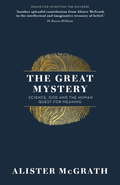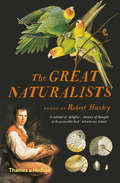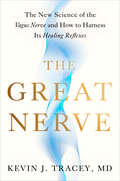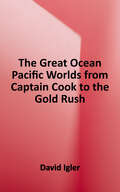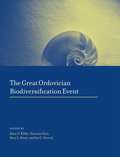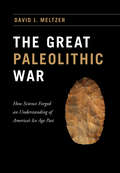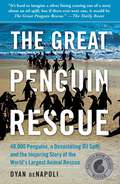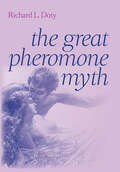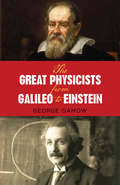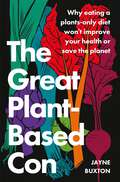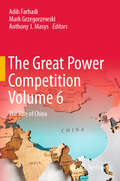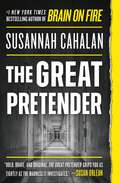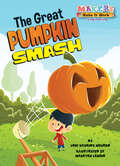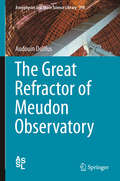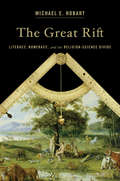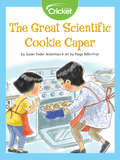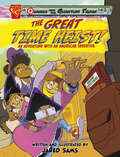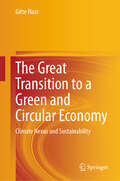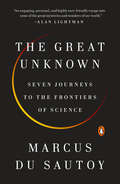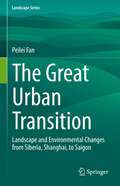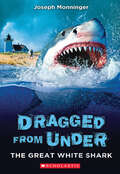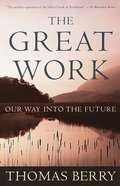- Table View
- List View
The Great Mystery: Science, God and the Human Quest for Meaning
by Dr Alister E McGrathThere is currently huge interest in the question of human nature and identity, and what the human future might look like. Who are we? Why are we here? What is our future? Are we alone? And what can religion bring, alongside biology and anthropology, to these important and exciting questions?The Great Mystery focuses on this fascinating field of study. Alister McGrath, bestselling author and Andreas Idreos Professor of Science and Religion at Oxford University, explores the question of human nature from both scientific and religious perspectives, and weaves together the results to open up and explore some of the deepest and most important questions about who we are, why we matter, and what our future might be. A follow-up to his critically acclaimed Inventing the Universe, in The Great Mystery Alister McGrath once again brings together science with religion to yield an enriched vision of reality, along with rigorous and thoroughly up-to-date scholarship and intellectual accessibility.
The Great Naturalists
by Robert HuxleyThe story of natural history as seen through the lives, observations, and discoveries of the world’s greatest naturalists. “How the sciences of geology, biology, ecology and paleontology developed over three centuries is wonderfully illuminated in this volume.” —Publishers Weekly We owe a debt of gratitude to the naturalists who described, experimented, collected, and gave us the means to understand the natural world. They came from all over the globe, from classical times to the end of the nineteenth century, when natural history changed from a mainly amateur pursuit to today’s specialized scientific profession. Braving dangers—including storms, pirates, and disease—in pursuit of cataloging the natural world, pioneers such as Alexander von Humboldt and Charles Darwin changed the course of science with their groundbreaking theories. This book includes many naturalists who are well known, such as the earliest great natural historian, Aristotle; Carl Linnaeus, the man who brought order to nature; the ornithologist and painter John James Audubon; and Georges Cuvier, who established the concept of extinction. Others are now given their rightful place: Antony van Leeuwenhoek, who made his own microscopes and discovered bacteria; and Mary Anning, “the princess of paleontology,” who had an amazing, self-taught talent for finding fossils. Many of these people were great artists as well as scientists, and The Great Naturalists is illustrated with a selection of beautiful and precise paintings and drawings of birds, animals, fossils, fish, shells, and rocks from the unparalleled collections of the Natural History Museum, London.
The Great Nerve: The New Science of the Vagus Nerve and How to Harness Its Healing Reflexes
by Kevin J. Tracey MDNew science reveals the groundbreaking potential of the vagus nerve to regulate your body&’s vital systems and heal a wide variety of medical conditions without drugsThe vagus nerve is fundamental to our health and vitality, coordinating critical functions from the precise heartbeat we need to exercise or rest to the balance of appetite and digestion. Made up of 200,000 fibers, the vagus nerve sends thousands of electrical signals every second between your brain and your most important organs. Yet despite its essential role in life, important vagus nerve functions have eluded centuries of scientific investigation. Now neurosurgeon and researcher Kevin Tracey has discovered the previously unknown power of the vagus nerve to reverse inflammation, balance the immune system, treat chronic illness, and keep our organs humming together in harmony. In The Great Nerve, Dr. Tracey shows us how stimulating the vagus nerve with a tiny electrical implant has the potential to reverse life-altering diseases like rheumatoid arthritis, inflammatory bowel disease, lupus, MS, diabetes, obesity, stroke, depression, Alzheimer&’s and Parkinson&’s. If this sounds too good to believe, Dr. Tracey shares stories of patients who have gone from being nearly bedridden to running and dancing, along with the science that makes possible these recoveries. He also explains the evidence for lifestyle strategies like ice baths, meditation, exercise, and breathwork that can maintain and improve vagus nerve function. By opening the door to the new field of neuroimmunology, The Great Nerve not only revolutionizes how we understand and treat disease, it gives us unprecedented hope for our health. This is the story of your body&’s ability to heal itself.
The Great Ocean: Pacific Worlds from Captain Cook to the Gold Rush
by David IglerThe Pacific of the early eighteenth century was not a single ocean but a vast and varied waterscape, a place of baffling complexity, with 25,000 islands and seemingly endless continental shorelines. But with the voyages of Captain James Cook, global attention turned to the Pacific, and European and American dreams of scientific exploration, trade, and empire grew dramatically. By the time of the California gold rush, the Pacific's many shores were fully integrated into world markets and world consciousness. The Great Ocean draws on hundreds of documented voyages--some painstakingly recorded by participants, some only known by archeological remains or indigenous memory--as a window into the commercial, cultural, and ecological upheavals following Cook's exploits, focusing in particular on the eastern Pacific in the decades between the 1770s and the 1840s. Beginning with the expansion of trade as seen via the travels of William Shaler, captain of the American Brig Lelia Byrd, historian David Igler uncovers a world where voyagers, traders, hunters, and native peoples met one another in episodes often marked by violence and tragedy. Igler describes how indigenous communities struggled against introduced diseases that cut through the heart of their communities; how the ordeal of Russian Timofei Tarakanov typified the common practice of taking hostages and prisoners; how Mary Brewster witnessed first-hand the bloody "great hunt" that decimated otters, seals, and whales; how Adelbert von Chamisso scoured the region, carefully compiling his notes on natural history; and how James Dwight Dana rivaled Charles Darwin in his pursuit of knowledge on a global scale. These stories--and the historical themes that tie them together--offer a fresh perspective on the oceanic worlds of the eastern Pacific. Ambitious and broadly conceived, The Great Ocean is the first book to weave together American, oceanic, and world history in a path-breaking portrait of the Pacific world.
The Great Ordovician Biodiversification Event
by Florentin Paris Mary L. Droser Ian G. Percival Barry D. WebbyTwo of the greatest evolutionary events in the history of life on Earth occurred during Early Paleozoic time. The first was the Cambrian explosion of skeletonized marine animals about 540 million years ago. The second was the "Great Ordovician Biodiversification Event," which is the focus of this book. This is the first book devoted specifically to establishing the global patterns of differentiation of Ordovician biotas through time and space. It provides extensive genus- and species-level diversity data for the many Ordovician fossil groups and presents an evaluation of how each group diversified, with assessments of patterns of change, and rates of origination and extinction.
The Great Ordovician Biodiversification Event (The Critical Moments and Perspectives in Earth History and Paleobiology)
by Barry D. Florentin Paris Mary L. Droser Ian G. Percival Eds. WebbyTwo of the greatest evolutionary events in the history of life on Earth occurred during Early Paleozoic time. The first was the Cambrian explosion of skeletonized marine animals about 540 million years ago. The second was the "Great Ordovician Biodiversification Event," which is the focus of this book. During the 46-million-year Ordovician Period (489–443 m.y.), a bewildering array of adaptive radiations of "Paleozoic- and Modern-type" biotas appeared in marine habitats, the first animals (arthropods) walked on land, and the first non-vascular bryophyte-like plants (based on their cryptospore record) colonized terrestrial areas with damp environments.This book represents a compilation by a large team of Ordovician specialists from around the world, who have enthusiastically cooperated to produce this first globally orientated, internationally sponsored IGCP (International Geological Correlation Program) project on Ordovician biotas. The major part is an assembly of genus- and species-level diversity data for the many Ordovician fossil groups. The book also presents an evaluation of how each group diversified through Ordovician time, with assessments of patterns of change and rates of origination and extinction. As such, it will become the standard work and data source for biotic studies on the Ordovician Period.
The Great Paleolithic War: How Science Forged an Understanding of America's Ice Age Past
by David J. MeltzerFollowing the discovery in Europe in the late 1850s that humanity had roots predating known history and reaching deep into the Pleistocene era, scientists wondered whether North American prehistory might be just as ancient. And why not? The geological strata seemed exactly analogous between America and Europe, which would lead one to believe that North American humanity ought to be as old as the European variety. This idea set off an eager race for evidence of the people who might have occupied North America during the Ice Age—a long, and, as it turned out, bitter and controversial search. In The Great Paleolithic War, David J. Meltzer tells the story of a scientific quest that set off one of the longest-running feuds in the history of American anthropology, one so vicious at times that anthropologists were deliberately frightened away from investigating potential sites. Through his book, we come to understand how and why this controversy developed and stubbornly persisted for as long as it did; and how, in the process, it revolutionized American archaeology.
The Great Penguin Rescue: 40,000 Penguins, a Devastating Oil Spill, and the Inspiring Story of the World's Largest Animal Rescue
by Dyan deNapoliON JUNE 23, 2000, the iron-ore carrier MV Treasure, en route from Brazil to China, foundered off the coast of Cape Town, South Africa, spilling 1,300 tons of oil into the ocean and contaminating the habitat of 75,000 penguins. Realizing thJuneat 41 percent of the world’s population of African penguins could perish, local conservation officials immediately launched a massive rescue operation, and 12,500 volunteers from around the globe rushed to South Africa in hopes of saving the imperiled birds.Serving as a rehabilitation manager during the initial phase of the three-month rescue effort, Dyan deNapoli—better known as "the Penguin Lady" for her extensive work with penguins—and fellow volunteers de-oiled, nursed back to health, and released into the wild nearly all of the affected birds. Now, at the tenth anniversary of the disaster, deNapoli recounts this extraordinary true story of the world’s largest and most successful wildlife rescue. When she first entered the enormous warehouse housing most of the 19,000 oiled penguins, the birds’ total silence told deNapoli all she needed to know about the extent of their trauma. African penguins are very vocal by nature, prone to extended fits of raucous, competitive braying during territorial displays and pair-bonding rituals, but these poor creatures now stood silently, shoulder to shoulder, in a state of shock. DeNapoli vividly details the harrowing rescue process and the heartbreaking scenarios she came up against alongside thousands of volunteers: unforgettable images of them laboriously scrubbing the oil from every penguin feather and force-feeding each individually; the excruciatingly painful penguin bites every volunteer received; and the wrenching decisions about birds too ill to survive. She draws readers headfirst into the exhausting physical and emotional experience and brings to life the cast of remarkable characters—from Big Mike, a compassionate Jiu-Jitsu champion with a booming voice, who worked every day of the rescue effort; to a man named Welcome, aka "the Penguin Whisperer," who had the amazing ability to calm any penguin he held in his arms; to Louis, a seventeen-year-old medical student who created a new formula for the highly effective degreaser used by the rescue mission—whose historic and heroic efforts saved the birds from near extinction. The extraordinary international collaboration of scientists, zookeepers, animal rescue groups, and thousands of concerned individuals helped save the African penguins—recently declared an endangered species—from an all-too-common man-made disaster.DeNapoli’s heartwarming and riveting story is not just a portrait of these captivating birds, nor is it merely a cautionary tale about the environment. It is also an inspirational chronicle of how following one’s passion can lead to unexpected, rewarding adventures—and illustrates not only how people from around the world can unite for a greater purpose, but how they can be extraordinarily successful when doing so. The Great Penguin Rescue will inspire readers to believe they can make a difference
The Great Pheromone Myth
by Richard L. DotyMammalian pheromones, audiomones, visuomones, and snarks—Richard Doty argues that they all belong in the same category: objects of imagination.For more than 50 years, researchers—including many prominent scientists—have identified pheromones as the triggers for a wide range of mammalian behaviors and endocrine responses. In this provocative book, renowned olfaction expert Richard L. Doty rejects this idea and states bluntly that, in contrast to insects, mammals do not have pheromones.Doty systematically debunks the claims and conclusions of studies that purport to reveal the existence of mammalian pheromones. He demonstrates that there is no generally accepted scientific definition of what constitutes a mammalian pheromone and that attempts to divide stimuli and complex behaviors into pheromonal and nonpheromonal categories have primarily failed. Doty's controversial assertion belies a continued fascination with the pheromone concept, numerous claims of its chemical isolation, and what he sees as the wasted expenditure of hundreds of millions of dollars by industry and government. The Great Pheromone Myth directly challenges ideas about the role chemicals play in mammalian behavior and reproductive processes. It is a must-have reference for biologists, psychologists, neuroscientists, and readers interested in animal behavior, ecology, and evolution.
The Great Physicists from Galileo to Einstein
by George Gamow"This book is Gamow at his best, which means the very best in science for the layman." -- Library JournalWidely recognized as one of the 20th century's foremost physicists, George Gamow was also an unusually capable popularizer of science. His talents are vividly revealed in this exciting and penetrating explanation of how the central laws of physical science evolved -- from Pythagoras' discovery of frequency ratios in the 6th century B.C. to today's research on elementary particles.Unlike many books on physics which focus entirely on fact and theory with little or no historic detail, the present work incorporates fascinating personal and biographical data about the great physicists of past and present. Thus Dr. Gamow discusses on an equal basis the trail of Galileo and the basic laws of mechanics which he discovered, or gives his personal recollections about Niels Bohr along with detailed discussion of Bohr's atomic model. You'll also find revealing glimpses of Newton, Huygens, Heisenberg, Pauli, Einstein, and many other immortals of science.Each chapter is centered around a single great figure, or at most two, with other physicists of the era and their contributions forming a background. Major topics include the dawn of physics, the Dark Ages and the Renaissance, Newtonian physics, heat as energy, electricity, the relativistic revolution, quantum theory, and the atomic nucleus and elementary particles.As Dr. Gamow points out in the Preface, the aim of this book is to give the reader the feeling of what physics is, and what kind of people physicists are. This delightfully informal approach, combined with the book's clear, easy-to-follow explanations, will especially appeal to young readers but will stimulate and entertain science enthusiasts of all ages. 1961 edition."The whole thing is a tour de force covering all the important landmarks." -- Guardian
The Great Plant-Based Con: Why eating a plants-only diet won't improve your health or save the planet
by Jayne BuxtonWINNER OF THE INVESTIGATIVE FOOD WORK AWARD AT THE GUILD OF FOOD WRITERS AWARDS 2023'The most incredible book' Delia Smith'Persuasive, entertaining and well researched' Sunday TimesPlant-based is best for health, go vegan to help save the planet, eat less meat... Almost every day we are bombarded with the seemingly incontrovertible message that we must reduce our consumption of meat and dairy - or eliminate them from our diets altogether.But what if the pervasive message that the plant-based diet will improve our health and save the planet is misleading - or even false? What if removing animal foods from our diet is a serious threat to human health, and a red herring in the fight against climate change.In THE GREAT PLANT-BASED CON, Jayne Buxton demonstrates that each of these 'what-ifs' is, in fact, a reality. Drawing on the work of numerous health experts and researchers, she uncovers how the separate efforts of a constellation of individuals, companies and organisations are leading us down a dietary road that will have severe repercussions for our health and wellbeing, and for the future of the planet.THE GREAT PLANT-BASED CON is neither anti-plant nor anti-vegan - it is a call for us to take an honest look at the facts about human diets and their effect on the environment. Shocking and eye-opening, this book outlines everything you need to know to make more informed decisions about the food you choose to eat.
The Great Plant-Based Con: Why eating a plants-only diet won't improve your health or save the planet
by Jayne BuxtonWINNER OF THE INVESTIGATIVE FOOD WORK AWARD AT THE GUILD OF FOOD WRITERS AWARDS 2023'The most incredible book' Delia Smith'Persuasive, entertaining and well researched' Sunday TimesPlant-based is best for health, go vegan to help save the planet, eat less meat... Almost every day we are bombarded with the seemingly incontrovertible message that we must reduce our consumption of meat and dairy - or eliminate them from our diets altogether.But what if the pervasive message that the plant-based diet will improve our health and save the planet is misleading - or even false? What if removing animal foods from our diet is a serious threat to human health, and a red herring in the fight against climate change.In THE GREAT PLANT-BASED CON, Jayne Buxton demonstrates that each of these 'what-ifs' is, in fact, a reality. Drawing on the work of numerous health experts and researchers, she uncovers how the separate efforts of a constellation of individuals, companies and organisations are leading us down a dietary road that will have severe repercussions for our health and wellbeing, and for the future of the planet.THE GREAT PLANT-BASED CON is neither anti-plant nor anti-vegan - it is a call for us to take an honest look at the facts about human diets and their effect on the environment. Shocking and eye-opening, this book outlines everything you need to know to make more informed decisions about the food you choose to eat.
The Great Power Competition Volume 6: The Rise of China
by Anthony J. Masys Adib Farhadi Mark GrzegorzewskiChina’s Belt and Road Initiative (BRI) represents a monumental shift in the global power landscape. Through ambitious infrastructure projects and strategic economic investments, China has emerged as a formidable challenger to U.S. dominance in the modern Great Power Competition (GPC), leveraging a unique blend of soft power and non-interference policy. This distinctive strategy has allowed China to rapidly gain footholds in resource rich regions such as Central Asia-South Asia (CASA) and the Middle East, compelling the U.S. to rethink its foreign policy approach in response. Given China’s adept leveraging of soft power in these geostrategic regions, the critical question arises: how can the U.S. meet the nuanced challenges of the modern GPC? The Great Power Competition Volume 6: The Rise of China delves into China’s calculated rise, exploring how the BRI has captivated nations spanning pivotal regions, entrenching Chinese influence across critical sectors. This edited volume brings together distinguished global experts and thought leaders to provide comprehensive analyses of China’s expanding influence across economic, political, technological, and security domains. The collection of essays offers critical insights and recommendations for navigating the modern-day great power competition in an era defined by China’s ascent. The book highlights China’s BRI brand diplomacy and its strategic use of soft power and non-interference policy to reshape the geopolitical landscape. The authors’ final analyses underscore that in the modern era of the GPC, strategic competition and soft power are deeply intertwined.
The Great Pretender: The Undercover Mission That Changed Our Understanding of Madness
by Susannah Cahalan"One of America's most courageous young journalists" and the author of the #1 New York Times bestselling memoir Brain on Fire investigates the untold history of the shocking experiment that revolutionized modern medicine (NPR). <P><P>For centuries, doctors have struggled to define mental illness--how do you diagnose it, how do you treat it, how do you even know what it is? In search of an answer, in the 1970s a Stanford psychologist named David Rosenhan and seven other people--sane, normal, well-adjusted members of society--went undercover into asylums around America to test the legitimacy of psychiatry's labels. <P><P>Forced to remain inside until they'd "proven" themselves sane, all eight emerged with alarming diagnoses and even more troubling stories of their treatment. Rosenhan's watershed study broke open the field of psychiatry, closing down institutions and changing mental health diagnosis forever. <P><P>But, as Cahalan's explosive new research shows, very little in this saga is exactly as it seems. What really happened behind those closed asylum doors, and what does it mean for our understanding of mental illness today?
The Great Pumpkin Smash (Makers Make It Work)
by Lori Haskins HouranFor Luke, autumn in Florida feels weird. There are no changing leaves, no cider, and worst of all, no pumpkin chucking! But maybe he can engineer a way to bring pumpkin spice to the south. Tying into the popular Makers Movement, Makers Make It Work is a series of fun easy-to-read stories that focus on problem-solving and hands-on action. This charming story explores the Makers theme of Engineering and includes explanatory sidebars and a catapult activity for young makers to try themselves!
The Great Refractor of Meudon Observatory
by Audouin DollfusThe large telescope at Meudon has become legendary. When it was conceived, after 1870, astronomy as a whole was limited to visual observation. Knowledge of the sky was limited to what one could see, assisted only by optical means. The large telescopes produced at this time produced larger images, permitting close-up views: the Meudon telescope was able to accomplish this perfectly. At Meudon, which became the Mecca of visual observation, the major planets were examined in a way that no other telescope had previously been able to. The telescope monitored the state of their atmospheres and mapped the appearance of their surfaces. Through the telescope, one could obtain photographs showing the nuclei of comets, revealing their very small size, and by using an eyepiece one could measure the separation of double stars. With a marvellous little instrument, the polarimeter, the nature of clouds in planetary atmospheres has been determined, and the type of surface material identified. Many more results were obtained, while photography, universally adopted, revolutionized other knowledge about the world. The sensitive emulsion, combined with large aperture reflecting telescopes, revealed the deepness and richness of the cosmos. The vast telescope of Meudon, which was the largest refracting telescope in Europe, became a legendary instrument and was symbolic of a new way to practice astronomy. Audouin Dollfus, a renowned astronomer, describes the great years of the Meudon telescope. He gives us the entire story of this instrument, from the birth of the concept that drove Jules Janssen at the end of the nineteenth century, to the idea that French astronomy could provide an outstanding telescope which would approach the limits of technical and industrial resources. The telescope remained unchanged until 2006, when the first steps toward restoration and public reopening were taken.
The Great Reversal
by David TabachnickEvery day, we are presented with new technologies that can influence human thought and action, such as psychopharmaceuticals, new generation performance enhancing drugs, elective biotechnology, and gastric bypass surgery. Have we let technology go too far in this respect? In The Great Reversal, David Edward Tabachnick contends that this question may not be unique to contemporary society. Through an assessment of the great works of philosophy and politics, Tabachnick explores the largely unrecognized history of technology as an idea.The Great Reversal takes the reader back to Aristotle's ancient warning that humanity should never allow technical thinking to cloud our judgment about what makes for a good life. It then charts the path of how we began to relinquish our deeply rooted intellectual and practical capacities that used to allow us to understand and regulate the role of technologies in our lives. As the rise of technology threatens our very humanity, Tabachnick emphasizes that we still may have time to recover and develop these capacities - but we must first decide how far we want to allow technology to determine our existence and our future.
The Great Rift: Literacy, Numeracy, and the Religion-Science Divide
by Michael E. HobartIn their search for truth, contemporary religious believers and modern scientific investigators hold many values in common. But in their approaches, they express two fundamentally different conceptions of how to understand and represent the world. Michael E. Hobart looks for the origin of this difference in the work of Renaissance thinkers who invented a revolutionary mathematical system—relational numeracy. By creating meaning through numbers and abstract symbols rather than words, relational numeracy allowed inquisitive minds to vault beyond the constraints of language and explore the natural world with a fresh interpretive vision. The Great Rift is the first book to examine the religion-science divide through the history of information technology. Hobart follows numeracy as it emerged from the practical counting systems of merchants, the abstract notations of musicians, the linear perspective of artists, and the calendars and clocks of astronomers. As the technology of the alphabet and of mere counting gave way to abstract symbols, the earlier “thing-mathematics” metamorphosed into the relational mathematics of modern scientific investigation. Using these new information symbols, Galileo and his contemporaries mathematized motion and matter, separating the demonstrations of science from the linguistic logic of religious narration. Hobart locates the great rift between science and religion not in ideological disagreement but in advances in mathematics and symbolic representation that opened new windows onto nature. In so doing, he connects the cognitive breakthroughs of the past with intellectual debates ongoing in the twenty-first century.
The Great Scientific Cookie Caper
by Susan Yoder AckermanLucas and Samia decide to use the scientific method when helping Grandma bake cookies. They change ingredients one by one to result in a unique cookie each time. Samia tries adding more flour for softer cookies, and Lucas tries adding melted butter with dissolved sugar for crispier cookies.
The Great Time Heist!: An Adventure with an American Inventor (Qianna and the Quantum Train)
by Jared SamsQianna is suffering the worst thing an inventor can experience—inventor's block! With the school science fair coming up, she'll do anything to defeat her rival, Maddy. That includes taking the Quantum Train back in time to “borrow” George Washington Carver's bag of ideas. Can two young inventors of color see eye-to-eye on how to use their science smarts? Find out in a dynamic graphic novel that gives science, engineering, and invention a hip-hop spin!
The Great Transition to a Green and Circular Economy: Climate Nexus and Sustainability
by Gitte HaarThe green transition is the way to a sustainable and fair planet, and necessary to secure supply chains, deliver predictable prices, and ensure access to raw materials despite resource scarcity through sustainable production and consumption.This book provides broad, essential insights into the main elements of the green transition, circular economy, and sustainability. Sustainability and the green transition will mean new market conditions for businesses. Companies will be subject to new legislation at the corporate and product level alike. They will need to meet new requirements, e.g., having to provide a tremendous amount of new non-financial ESG data to deliver transparency and traceability in the value chains of products and businesses. The book aims to close the gaps between science, society, and business. To do so, it describes the complexity of sustainability and the need for a holistic approach. In addition, it provides solutions, tools and methods to transform today’s linear economy, make businesses ready for the future, and create a society that no longer pushes the planet beyond its limits.
The Great Unknown: Seven Journeys to the Frontiers of Science
by Marcus Du Sautoy“Brilliant and fascinating. No one is better at making the recondite accessible and exciting.” —Bill Bryson A captivating journey to the outer reaches of human knowledgeEver since the dawn of civilization we have been driven by a desire to know. But are there limits to human knowledge? Are some things beyond the predictive powers of science and the capacities of the human brain? Or are those challenges the next big discovery waiting to happen? In The Great Unknown, one of the world’s most brilliant mathematicians takes us into the minds of science’s greatest innovators as he probes the many mysteries we have yet to solve. From the very large to the very small, from the distant future to the deep past, from the complexities of the human brain to the infinities of mathematics, Marcus du Sautoy invites us to join him on a journey to the seven frontiers of knowledge, the outer edges where scientists are actively grappling with the unknown. Can we locate consciousness in the brain? What is dark energy made of? Can we speak of time before the Big Bang? Is it possible to predict the future? At once exhilarating and mind bending, The Great Unknown will challenge you to think in new ways about every aspect of the known world. Du Sautoy reminds us that major breakthroughs were often ridiculed at the time of their discovery and invites us to consider big questions—about who we are and the nature of God—that even the most creative scientists have yet to answer definitively.
The Great Urban Transition: Landscape and Environmental Changes from Siberia, Shanghai, to Saigon (Landscape Series #34)
by Peilei FanThis monograph examines the (sub)urbanization process of seven transitional economies in Southeast, East, and North Asia (SENA), i.e., Siberia of Russia in North Asia, China and Mongolia in East Asia, and Cambodia, Lao PDR, Myanmar, and Vietnam in Southeast Asia. In ten chapters, great urban transformation occurred in SENA is discussed, as well as the transitional period which aggravated urban environments in SENA cities and how ‘institutional shift,’ enabled by movements of urban residents and transitional urban governance, may facilitate the process and improve the urban environmental condition. This book includes land cover and land use data derived from satellite images over the past thirty years and intensive field research in more than thirty cities exploring the rise of these great cities and their environmental challenges. Unlike in western countries, the current urbanization process in Asian transitional economies is a hybrid product of market logic and state legacy and intervention, with these influences sometimes conflicting and at other times enhancing each other, under intensified globalization. This book is of interest to researchers and students interested in landscape, urban studies, environment studies in particularly Asia, as well as planners and policy makers.
The Great White Shark (Dragged from Under #2)
by Joseph MonningerDANGER FROM THE DEPTHS!In beautiful Cape Cod, a fatal Great White attack rocks the popular tourist destination. As the beaches are closed and locals grow angry, a recently arrived Barn Whimbril heads straight into the action. But with a group of local teens determined to surf no matter what or who gets in the way, can Barn safely investigate the attack or will he come face-to-face with the ocean's most feared apex predator?
The Great Work: Our Way into the Future
by Thomas BerryThomas Berry is one of the most eminent cultural historians of our time. Here he presents the culmination of his ideas and urges us to move from being a disrupting force on the Earth to a benign presence. This transition is the Great Work -- the most necessary and most ennobling work we will ever undertake. Berry's message is not one of doom but of hope. He reminds society of its function, particularly the universities and other educational institutions whose role is to guide students into an appreciation rather than an exploitation of the world around them. Berry is the leading spokesperson for the Earth, and his profound ecological insight illuminates the path we need to take in the realms of ethics, politics, economics, and education if both we and the planet are to survive.From the Trade Paperback edition.
